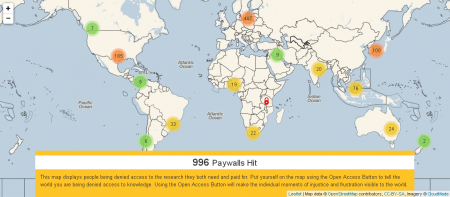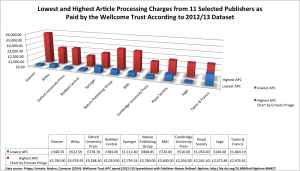Just in time before the College closes for the Christmas break I have found the time to write my overdue summary of recent developments in the world of open access and scholarly communication. Below are a few of the headlines and developments that caught my eye during the last couple of months.
Cost of Open Access
Commissioned by London Higher and SPARC Europe, Research Consulting have published Counting the Costs of Open Access. Using data provided by universities, including Imperial College, it concludes that there was a £9.2m cost to UK research organisations for achieving compliance with RCUK’s open access policy in 2013/14. Main conclusions are quoted below – the estimated costs for meeting REF open access requirements are particularly interesting seeing as HEFCE do not provide any funding for their in some ways even more ambitious open access policy:
- The time devoted to OA compliance is equivalent to 110 fulltime staff members across the UK.
- The cost of meeting the deposit requirements for a post-2014 REF is estimated at £4-5m per annum.
- Gold OA takes 2 hours per article, at a cost of £81.
- Green OA takes just over 45 minutes, at a cost of £33.
Pinfield, Salter and Bath published: The ‘total cost of publication’ in a hybrid open-access environment. The study analyses data from 23 UK institutions, including Imperial College, covering the period 2007 to 2014. It finds that while the mean value of APCs has been relatively stable, ‘hybrid’ subscription/OA journals were consistently more expensive than fully-OA journals. Modelling shows that APCs are now constituting 10% of the total cost of ownership for publishing (excluding administrative costs).
EBSCO’s 2015 Serials Price Projection Report assumes price increase of 5-7%, not including a recommended additional 2-4% to allow for currency fluctuations.
John Ulmschneider, Librarian at the Virginia Commonwealth University, estimates that with current price increases the cost for subscription payments would “eat up the entire budget for this entire university in 20 years”. Partly in response to that, VCU has launched its own open access publishing platform.
UK Funder News
Arthritis Research UK, Breast Cancer Campaign, the British Heart Foundation (BHF), Cancer Research UK, Leukaemia & Lymphoma Research, and the Wellcome Trust have joined together to create the Charity Open Access Fund (COAF). COAF operates in essentially the same way as the WT fund it replaces.
An article summarising responses to the RCUK review of open access cites the Wellcome Trust saying that sanctions could accelerate the implementation of open-access.
The Wellcome Trust published a list of journals that do not provide a compliant publishing option.
International Funder News
A new Danish open access strategy sets the goal to reach Open Access to 80% of all publically funded peer-reviewed articles in 2017, concluding with 100% in 2022.
The Open Access policy of the Austrian FWF requires CC BY (if Gold OA) and deposit in a sustainable repository on publication. The FWF covers APCs up to a limit of €2500.
Research Information published a summary of international developments around open access: The Research Council of Norway is making funding available to cover up to 50% of OA publishing charges. The Chinese Academy of Sciences and the National Natural Science Foundation of China require deposit of papers in an OA repository within 12 months of publication. The Mexican president has signed an act to provide “Mexicans with free access to scientific and academic production, which has been partially or fully financed by public funds”.
Publishers and Open Access
In November, negotiations between Elsevier and the Dutch universities broke down following an Elsevier proposal that “totally fails to address this inevitable change [to open access]”. The universities have since reached an agreement with Springer; negotiations with Elsevier have resumed.
The launch of Science Advances, a journal of the American Association for the Advancement of Science (AAAS), prompted strong criticism of the AAAS approach to open access. Over a hundred scientists signed an open letter criticising AAAS for charging $1000 for the CC BY license as well as $1500 for papers longer than ten pages – on top of a $3000 base APC. This has been picked up by media including the New Statesman.
The Nature Publishing Group has had two major OA-related headlines. Generally well received was the announcement that NPG would switch the prestigious Nature Communications to full open access. On the other hand, the move to give, limited, read access to articles has been widely criticised as beggar access and a step back for open access: NPG allow those with a subscription to give others viewing (not printing) access to papers, through a proprietary software.
An open letter signed by nearly 60 open access advocates, publishers, library organisations and civil society bodies warns against model licenses governing copyright on open access articles proposed by the International Association of Scientific, Technical & Medical Publishers (STM). The letter says the STM licences “would limit the use, reuse and exploitation of research” and would “make it difficult, confusing or impossible to combine these research outputs with other public resources”. The STM licenses are seen as incompatible with Creative Commons licences.
Jisc and Wiley have negotiated a deal that provides credits for article processing charges (APCs) to universities that license Wiley journal content and have a Wiley OA account.






